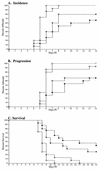Use of immunostimulatory sequence-containing oligonucleotides as topical therapy for genital herpes simplex virus type 2 infection
- PMID: 12388699
- PMCID: PMC136753
- DOI: 10.1128/jvi.76.22.11387-11396.2002
Use of immunostimulatory sequence-containing oligonucleotides as topical therapy for genital herpes simplex virus type 2 infection
Abstract
Synthetic oligonucleotides containing CpG motifs in specific sequence contexts have been shown to induce potent immune responses. We have evaluated mucosal administration of two immunostimulatory sequence (ISS)-containing phosphorothioate-stabilized oligonucleotides for antiherpetic efficacy in animal models. The ISS oligonucleotides, suspended in phosphate-buffered saline, were tested in mouse and guinea pig vaginal models of herpes simplex virus type 2 (HSV-2) infection. For comparison, groups of untreated, non-ISS oligonucleotide-treated, and acyclovir-treated animals also were monitored. The results indicated that vaginal epithelial application of ISS (up to 6 h after viral inoculation) with mice lethally challenged with HSV-2 delayed disease onset and reduced the number of animals that developed signs of disease (P = 0.003). ISS application significantly increased survival rates over those of controls (P = 0.0014). The ISS also impacted an established infection in the guinea pig model of HSV-2 disease. A single administration of ISS (21 days after viral inoculation) significantly reduced the frequency and severity of HSV-2 lesions compared to results with non-ISS oligonucleotide-treated and untreated guinea pigs (P < 0.01). HSV-2 is shed from the vaginal cavity of the guinea pig in the absence of lesions, similar to the case with humans. As an additional indication of ISS efficacy, the magnitude of viral shedding also was significantly reduced in ISS-treated animals (P < 0.001). These effects appeared to be immunologically mediated, since ISS had no direct effect on HSV-2 replication in vitro using standard plaque assays. These data suggest that ISS may be useful in the treatment and control of genital herpes in humans.
Figures



Similar articles
-
Pathogenesis of acyclovir-resistant herpes simplex type 2 isolates in animal models of genital herpes: models for antiviral evaluations.Antiviral Res. 2000 Sep;47(3):159-69. doi: 10.1016/s0166-3542(00)00104-2. Antiviral Res. 2000. PMID: 10974368
-
A vaccine containing highly purified virus particles in adjuvant provides high level protection against genital infection and disease in guinea pigs challenged intravaginally with homologous and heterologous strains of herpes simplex virus type 2.Vaccine. 2020 Jan 3;38(1):79-89. doi: 10.1016/j.vaccine.2019.09.090. Epub 2019 Oct 11. Vaccine. 2020. PMID: 31611098
-
Treatment of primary herpes simplex virus infection in guinea pigs by imiquimod.Antiviral Res. 1999 Nov;44(1):31-42. doi: 10.1016/s0166-3542(99)00052-2. Antiviral Res. 1999. PMID: 10588331
-
Use of the Guinea pig model of genital herpes to evaluate vaccines and antivirals: Review.Antiviral Res. 2020 Aug;180:104821. doi: 10.1016/j.antiviral.2020.104821. Epub 2020 Jun 13. Antiviral Res. 2020. PMID: 32544409 Free PMC article. Review.
-
An update on short-course episodic and prevention therapies for herpes genitalis.Herpes. 2007 Jun;14 Suppl 1:5A-11A. Herpes. 2007. PMID: 17877886 Review.
Cited by
-
Loss of the type I interferon pathway increases vulnerability of mice to genital herpes simplex virus 2 infection.J Virol. 2011 Feb;85(4):1625-33. doi: 10.1128/JVI.01715-10. Epub 2010 Dec 8. J Virol. 2011. PMID: 21147921 Free PMC article.
-
Pan-HSV-2 IgG antibody in vaccinated mice and guinea pigs correlates with protection against herpes simplex virus 2.PLoS One. 2013 Jun 6;8(6):e65523. doi: 10.1371/journal.pone.0065523. Print 2013. PLoS One. 2013. PMID: 23755244 Free PMC article.
-
Induction of innate immunity against herpes simplex virus type 2 infection via local delivery of Toll-like receptor ligands correlates with beta interferon production.J Virol. 2006 Oct;80(20):9943-50. doi: 10.1128/JVI.01036-06. J Virol. 2006. PMID: 17005672 Free PMC article.
-
Expression of toll-like receptors in genital tract tissues from normal and HIV-infected men.Am J Reprod Immunol. 2011 Jan;65(1):28-43. doi: 10.1111/j.1600-0897.2010.00877.x. Am J Reprod Immunol. 2011. PMID: 20528831 Free PMC article.
-
The Toll-like receptor 7 (TLR7) agonist, imiquimod, and the TLR9 agonist, CpG ODN, induce antiviral cytokines and chemokines but do not prevent vaginal transmission of simian immunodeficiency virus when applied intravaginally to rhesus macaques.J Virol. 2005 Nov;79(22):14355-70. doi: 10.1128/JVI.79.22.14355-14370.2005. J Virol. 2005. PMID: 16254370 Free PMC article.
References
-
- Ali, S., S. A. Leonard, C. A. Kukoly, W. J. Metzger, W. R. Wooles, J. F. McGinty, M. Tanaka, A. Sandrasagra, and J. W. Nyce. 2001. Absorption, distribution, metabolism, and excretion of a respirable antisense oligonucleotide for asthma. Am. J. Respir. Crit. Care Med. 163:989-993. - PubMed
-
- Ballas, Z. K., W. L. Rasmussen, and A. M. Krieg. 1996. Induction of NK activity in murine and human cells by CpG motifs in oligodeoxynucleotides and bacterial DNA. J. Immunol. 157:1840-1845. - PubMed
-
- Bernstein, D. I., C. J. Harrison, M. A. Tomai, and R. L. Miller. 2001. Daily or weekly therapy with resiquimod (R-848) reduces genital recurrences in herpes simplex virus-infected guinea pigs during and after treatment. J. Infect. Dis. 183:844-849. - PubMed
-
- Bourne, N., J. Ireland, L. R. Stanberry, and D. I. Bernstein. 1999. Effect of undecylenic acid as a topical microbicide against genital herpes infection in mice and guinea pigs. Antivir. Res. 40:139-144. - PubMed
Publication types
MeSH terms
Substances
Grants and funding
LinkOut - more resources
Full Text Sources
Other Literature Sources
Medical
Research Materials

